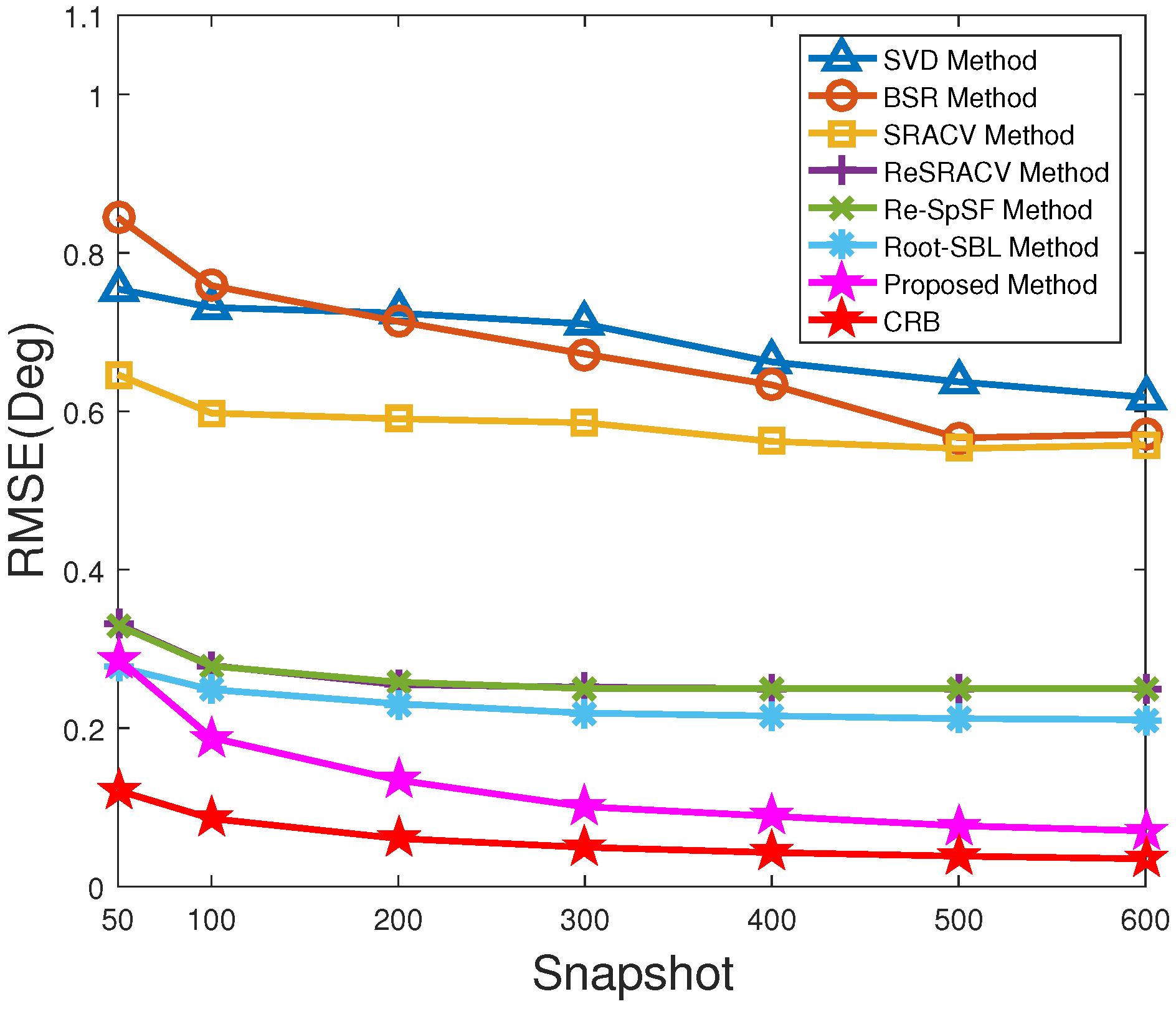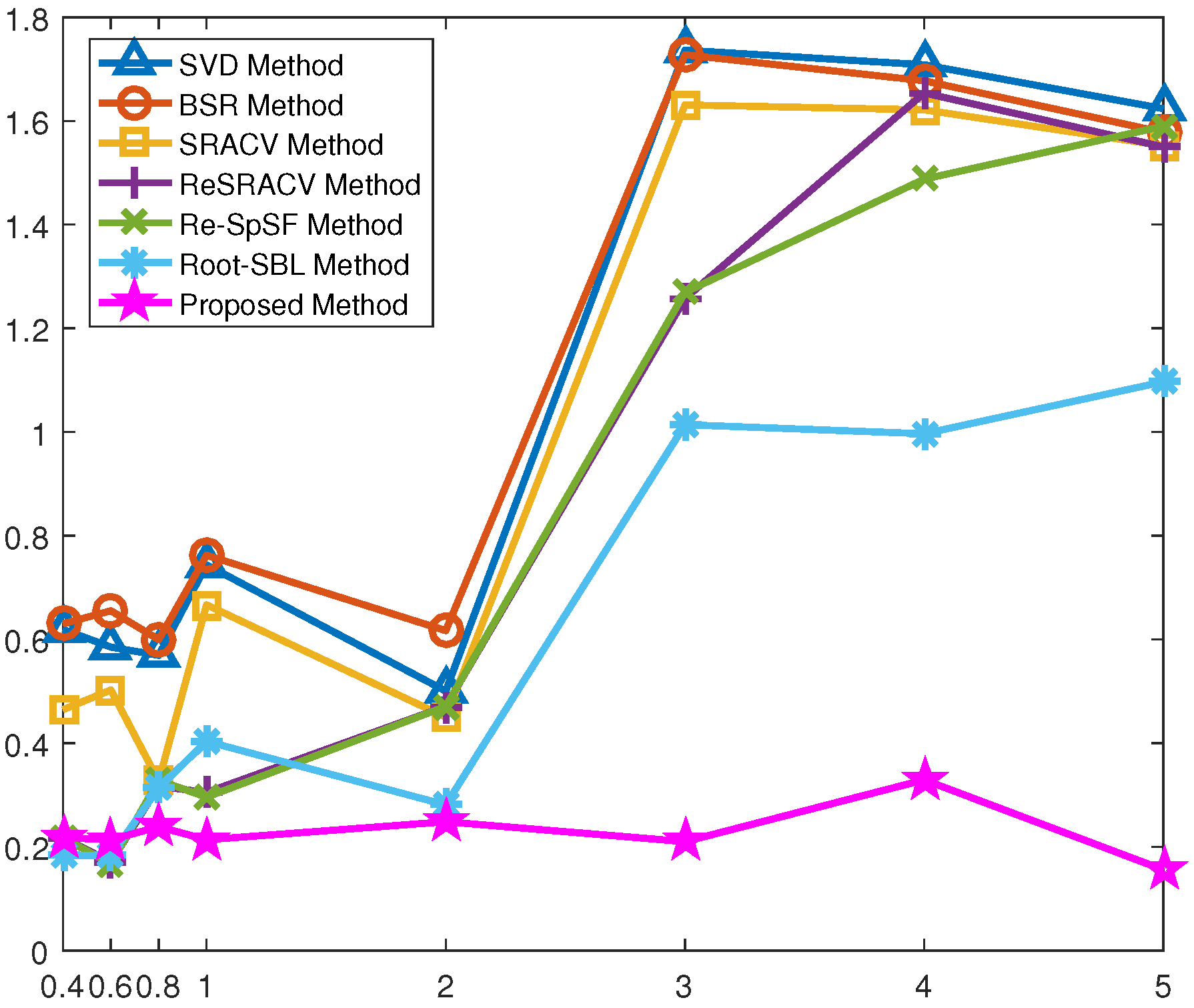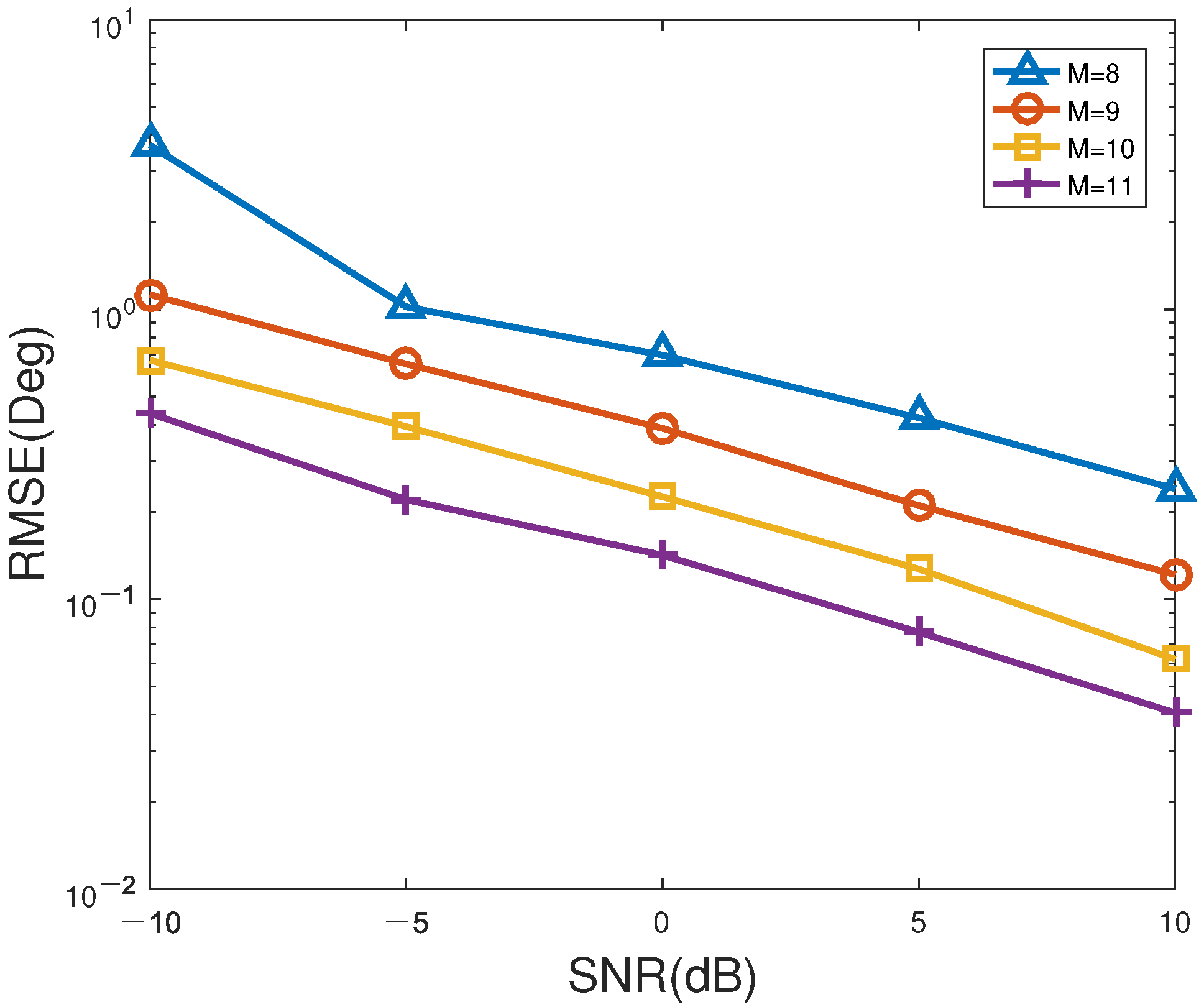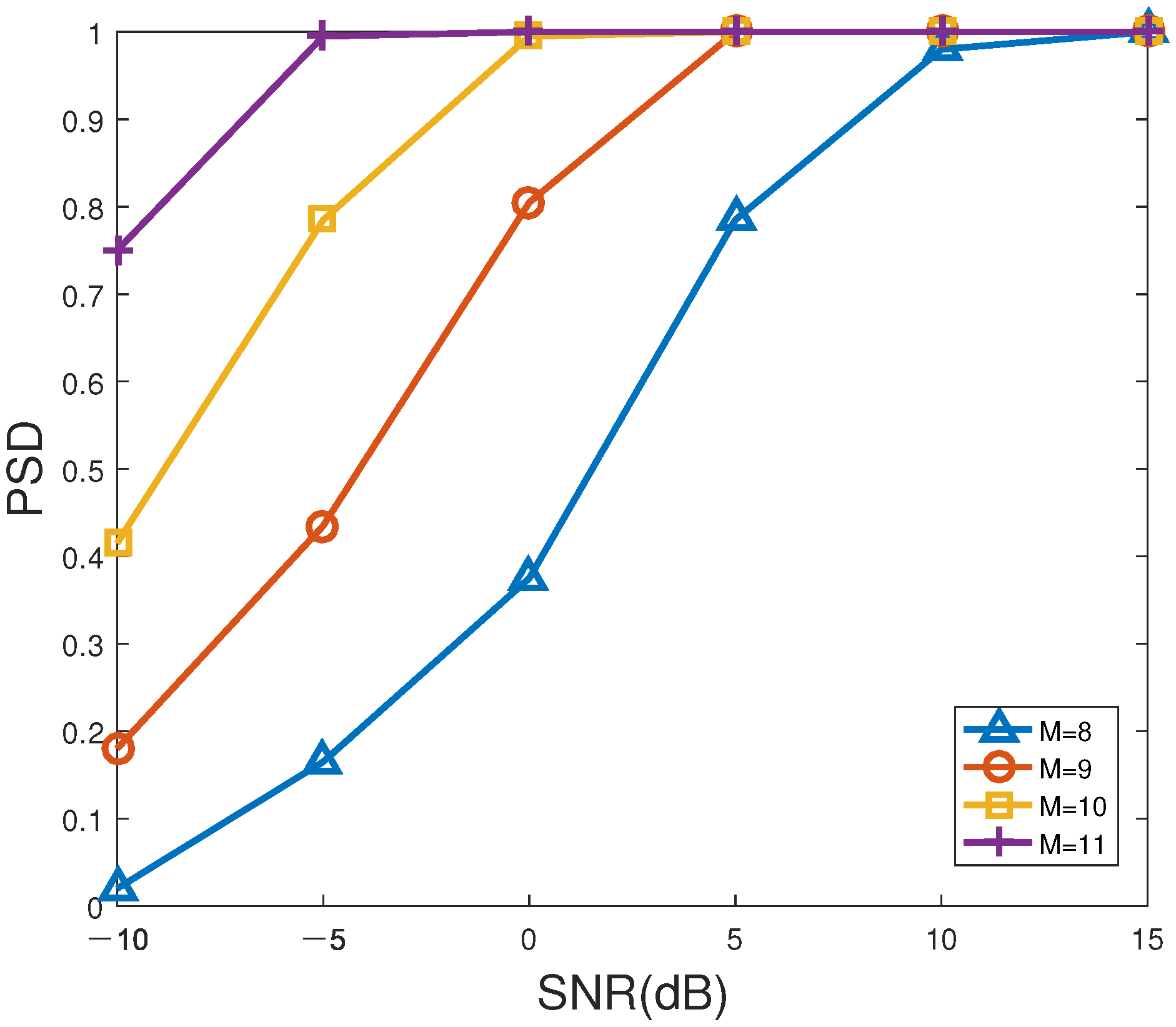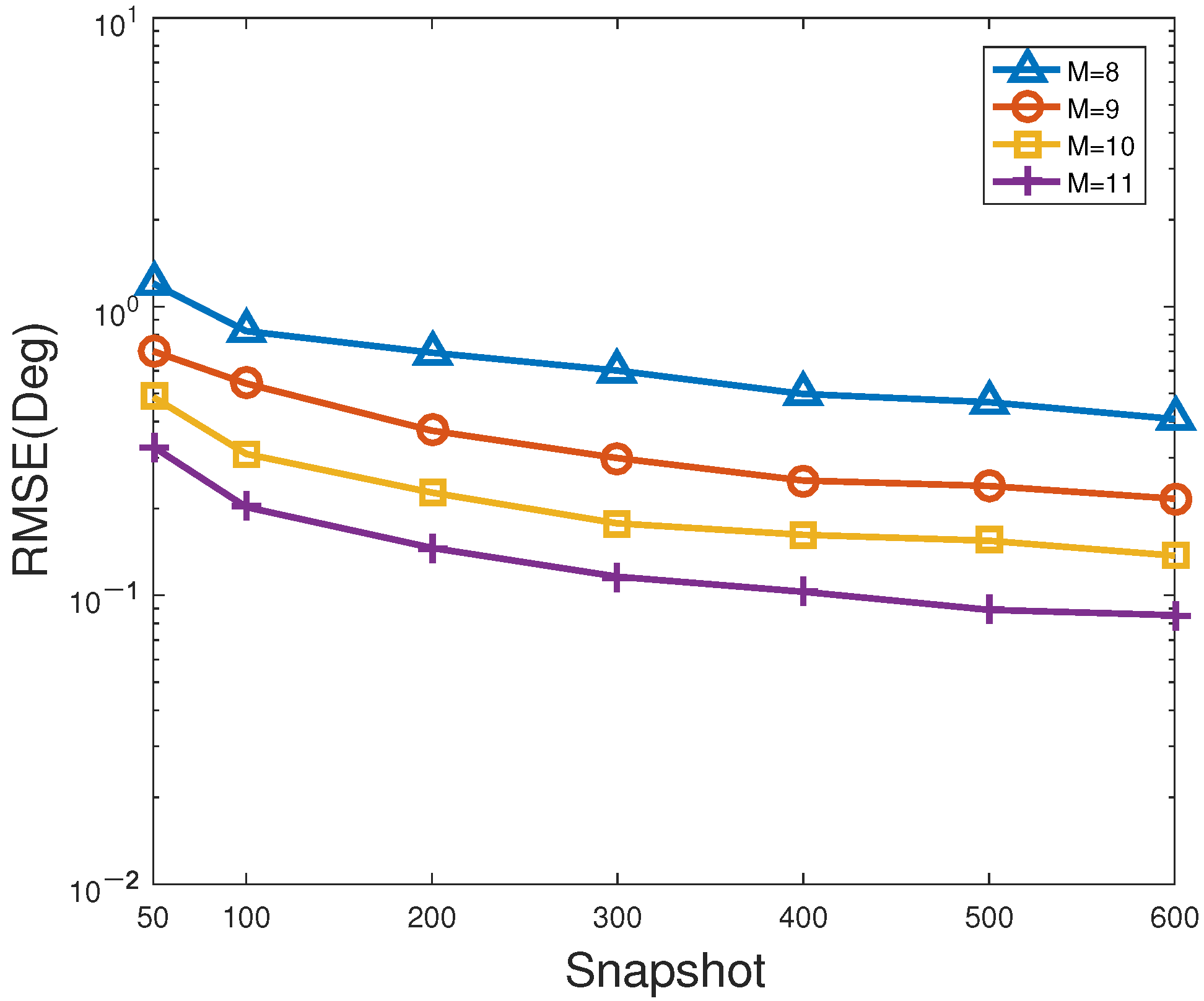1. Introduction
Parameter estimation has drawn widespread concern and become a research hotspot in the field of array signal processing over the past few decades, especially for direction-of-arrival (DOA) estimation [
1,
2]. To the best of our knowledge, DOA estimation mainly uses sensor array to sample, analyze, and process spatial signals, achieving azimuth and elevation angles estimation for interested targets. It is one of the research foundations and vital components of parameter estimation, which provides precious angle information, and even prepares for subsequent parameter information like position. It is generally encountered in various real-life applications, such as unmanned aerial vehicles (UAV), vehicle localization, navigation, etc [
3,
4].
Currently, these efforts towards direction finding can be roughly grouped into two categories, i.e., subspace technologies [
5,
6,
7,
8] and sparse signal recovery (SSR) attempts [
9,
10,
11,
12,
13]. The former are represented by the multiple signal classification (MUSIC) algorithm [
5] and the estimation of signal parameters via rotational invariance techniques (ESPRIT) algorithm [
6], officially opening the era of super-resolution direction finding. Afterwards, subspace estimators [
7,
8] are successively refined from different aspects, such as accuracy and robustness. These subspace frameworks largely rest with the eigenvalue decomposition (EVD) of the covariance matrix to decouple the subspaces, and then exploit the inherent relationships between the array manifolds and the decoupled subspaces to estimate DOAs. However, they are quite susceptible to the effects of signal-to-noise ratio (SNR), snapshots number, coherent targets, etc. In other words, it is hard for them to obtain the desirable performance under relatively harsh direction finding circumstances, such as unsatisfactory SNR and insufficient snapshots. Motivated by the potential spatial sparsity of the targets, the SSR perspective based on the principle of Compressed Sensing (CS) [
14,
15] came into being to solve the above problem. Subsequently, a set of sparsity-aware estimators are structured, including convex optimization attempts [
9,
10,
11] and sparse Bayesian learning (SBL) efforts [
12,
13]. Simultaneously, plenty of research results have shown that this not only improves the estimation accuracy under the conditions of undesirable SNR and snapshots, but also enhances the robustness to coherent sources [
16].
In terms of SBL-based approaches, their estimation accuracy relies heavily on the discretization degree of the investigated spatial domain. The higher the discretization degree (i.e., the denser the grid points), the smaller the grid interval, and the heavier the computational burden, while the lower the discretization degree (i.e., the sparser the grid points), the larger the grid interval, and the greater the mismatches between the desired DOAs and the closest candidate directions. Since it is almost impossible to ensure that all sources fall precisely on the predefined candidate directions, it is hard for the targets to avoid off-grid error caused by such mismatch.
Many attempts have been made in view of off-grid DOA estimation [
17,
18,
19,
20,
21]. A Sparse Spectrum Fitting with Modeling Uncertainty (SpSFMU) scheme [
17] is developed by linearly approximating the off-grid gap in the closest candidate grid points. Compared to its on-grid SpSF framework, it allows continuous DOA estimation, enhancing the estimation accuracy or/and relieving the computational load. Inspired by the linear approximation, a novel off-grid sparse Bayesian inference (OGSBI) approach [
18] is presented with the assumption that the off-grid gap is uniformly distributed within the grid interval, where the off-grid gap is ultimately calculated by the expectation maximization (EM) strategy. As shown in [
19], a robust block-sparse Bayesian learning framework without noise variance estimation is further derived via employing the sample covariance matrix. Despite these approaches [
18,
19] being robust to off-grid gap, it is computationally expensive for them to achieve satisfactory estimation accuracy, and their performance remains unacceptable under the condition of very coarse grids. For realizing a satisfactory performance under the coarse grid condition without aggravating the computational load, a robust root off-grid sparse Bayesian learning (Root-OGSBL) method [
20] is designed, which dynamically upgrades predefined grid points via solving a polynomial to reduce off-grid error. Inspired by [
20], a modified off-grid SBL (Re-OGSBL) approach [
21] with a forgotten factor scheme is reported to further refine the dynamic update procedure for grid points.
Although these attempts have some attractive properties, they all either explicitly or implicitly require ideal array manifolds. In reality, there are plenty of array manifold perturbations in complex circumstances, such as unknown mutual coupling [
22,
23] and gain-phase error [
24,
25]. It should be noted that for a selected array, the more antennas, the smaller their spacing, and the more likely to cause space electromagnetic fields interaction between sensors. In this way, closely-spaced antennas are greatly vulnerable to unknown mutual coupling effect, destroying the desirable array manifold structure and making these approaches damaged or invalid in complex electromagnetic environments.
Therefore, many efforts have been devoted to DOA estimation in unknown mutual coupling [
26,
27,
28,
29,
30,
31,
32,
33]. Motivated by the spirit of array compensation, a group of auxiliary antennas are additionally placed on the two boundaries of the initial array to avoid the unknown mutual coupling influence, facilitating the direct utilization of the MUSIC principle [
26]. Different from [
26], a specific selection matrix [
27] is structured to achieve array compensation through choosing sensors at the ends of the original array to be auxiliary ones. This attempt provides acceptable direction finding performance with low computational complexity, although at the cost of array aperture. Subsequently, the parameterized decoupling work [
28] is reported to decouple the DOA information from the unknown mutual coupling. Despite preserving the entire array aperture well, it leads to a high computational burden. Except for the attempts achieved by subspace techniques in [
26,
27,
28], a series of decoupling investigations on unknown mutual coupling interference have been conducted from the perspective of SSR [
29,
30,
31,
32,
33]. As discussed in [
29], an enhanced
-SVD (singular value decomposition) approach is introduced via using a selection matrix. Afterwards, a block sparse recovery (BSR) estimator [
30] is developed in the data domain by parameterizing the coupled array manifold. Following the idea of parameterized decoupling, a robust BSR framework of array covariance vectors is reported as well [
31]. However, it is still subject to the
-norm approximation, causing limited recovery performance. Afterwards, weighting techniques have received keen attention for their wide applications in parameter estimation [
32,
33], data fusion [
34,
35], error estimation [
36,
37], etc. Among them, weighting research on DOA estimation, i.e., the reweighted BSR approaches [
32,
33], are performed to enforce the solution’s sparsity for improving the estimation accuracy of the angle parameter. Unfortunately, whether the schemes with off-grid error [
17,
18,
19,
20,
21] or the frameworks under unknown mutual coupling [
26,
27,
28,
29,
30,
31,
32,
33], they focus on only one factor that we are interested in, i.e., off-grid error or unknown mutual coupling.
In fact, there are few studies on off-grid DOA estimation under unknown mutual coupling [
38,
39,
40]. According to [
38], a revised Root-OGSBL (Root-SBL) method is reported for off-grid estimation with unknown mutual coupling. Moreover, a novel sparse Bayesian learning with mutual coupling (SBLMC) estimator [
39] for MIMO radar is developed by the expectation maximum (EM) principle to iteratively update unknown parameters, such as noise variance, mutual coupling coefficients, and off-grid gap vector. Nevertheless, such estimation superiority is at the expense of computational burden. Subsequently, an off-grid sparse recovery algorithm under unknown mutual coupling (OGSRMC) [
40] is presented by iteratively updating DOAs, unknown mutual coupling, and off-grid parameters, which is superior in computational complexity and inferior in estimation accuracy to the SBLMC method.
In this work, a reweighted off-grid SpSF (Re-OGSpSF) scheme is presented for DOA estimation in the environment of unknown mutual coupling. The proposed estimator not only incorporates the off-grid error term into the underlying on-grid sparse recovery model to enhance the robustness, but also utilizes the reweighted strategy to ensure accuracy. Hence, the proposed Re-OGSpSF framework can realize high-precision continuous DOA estimation with low computational burden by adopting a coarse grid interval. Massive experimental results are displayed to validate the above inferences. The main contributions of this paper are listed as follows:
- (1)
Designing a selection matrix to eliminate the unknown mutual coupling interference;
- (2)
Formulating an improved off-grid SpSF (OGSpSF) framework for off-grid DOA estimation by joint sparse recovery;
- (3)
Developing a MUSIC-like weighted matrix to reweight the OGSpSF scheme for strengthening the solution’s sparsity.
The remainder of this article is structured as follows: In
Section 2, an actual data model affected by unknown mutual coupling is first defined. Then, a novel Re-OGSpSF scheme is explored for direction finding with unknown mutual coupling of the sensor array in
Section 3. Subsequently,
Section 4 presents the relevant remarks of this work. Afterwards, a series of simulation results are given to validate the superiority of the proposed framework in
Section 5. Finally,
Section 6 presents the conclusion of this paper.
Additionally, the relevant key notations involved in this work are explained in the following
Table 1.
2. The Coupled Signal Model
Consider a uniform linear array (ULA) configured with
M omnidirectional sensors, each separated by the spacing
d.
, where
refers to the signal wavelength.
K narrowband uncorrelated sources
are incident on the ULA from distinct directions
, where there is reason to believe that
K is known exactly in advance [
24,
25]. Therefore, the ideal array output can be structured as
where
means the ideal received data.
reveals the signal vector.
represents a stochastic Gaussian white noise vector, which follows
with noise power
.
denotes the array manifold matrix, where
refers to the steering vector with
.
For a fixed array, the greater the number of antennas, the closer the sensors, and the greater the possibility of space electromagnetic fields interaction between them. In other words, the sensors are too close to escape such interaction, causing unknown mutual coupling disturbance between closely-spaced sensors. Under such a scenario, the ideal structure of the array manifold is disturbed and then coupled as
where
represents a mutual coupling matrix (MCM). According to [
26], it is rational for MCM to depict its intrinsic properties with the complex banded symmetric Toeplitz structure. The mutual coupling coefficients between the sensors are inversely proportional to their spacing, i.e., the greater the antenna distance, the smaller the mutual coupling coefficients. What is more, the magnitude of the mutual coupling coefficient decreases rapidly when the antenna spacing increases [
23]. In this way, it is reasonable to assume that the sensors far enough away are immune to the effect of unknown mutual coupling, i.e., the corresponding coefficients in the MCM are zero. Therefore, MCM is typically modeled as a banded symmetric Toeplitz matrix with just a few nonzero coefficients [
23,
29], i.e.,
where
reveal
H unknown non-zero mutual coupling coefficients that satisfy
.
Under the condition of unknown mutual coupling, (
1) should be rewritten as
By collecting
T snapshots, the coupled array output matrix can be formed as
where
refers to the coupled array output.
reveals the coupled array manifold matrix with
.
is the source matrix.
indicates the noise matrix.
5. Numerical Simulation Results
In this section, extensive simulation experiments are performed to validate the estimation performance of the proposed Re-OGSpSF scheme. In order to show the effectiveness and efficiency, several estimators are simultaneously tested to compare with the proposed approach, including the
-SVD algorithm (recorded as SVD method) in [
29], the BSR approach in [
30], the SRACV method in [
31], the reweighted SRACV framework (recorded as ReSRACV method) in [
32], the potential Re-SpSF scheme (recorded as Re-SpSF method) in (
40), and the Root-SBL estimator in [
38]. Furthermore, as a benchmark for performance evaluation, the Cramer–Rao bound (CRB) in [
41] is calculated as well. Additionally, the root means square error (RMSE) is computed to measure their accuracy, denoted as
where
reveals the estimated value of the desired DOA
at the
lth Monte Carlo running.
stands for the total number of Monte Carlo trials in this article.
In what follows, sensors are configured to structure a ULA, which are evenly separated by half-wavelength spacing, i.e., . Suppose there are narrow-band uncorrelated targets from distinct directions incident on the ULA, where DOAs are recorded as and , respectively. Moreover, there are three non-zero coefficients in the MCM with , that is, , , and . In addition, the discrete grid spacing of the spatial domain from to is set to .
Figure 1 describes the spatial spectrum of all estimators with
dB and
. Additionally, their corresponding estimation results are recorded in
Table 2. On the one hand, there are two sharp peaks for these approaches in
Figure 1, implying that they are able to maintain direction finding under unknown mutual coupling and off-grid conditions. What is more, it is not hard to find that the peaks of the Root-SBL approach are the least sharp and the sidelobe is the highest, while the peaks of the potential Re-SpSF and the proposed methods are the sharpest and the sidelobes are the lowest. On the other hand,
Table 2 depicts the proposed method outperforms the Re-SpSF and ReSRACV algorithms, and is the closest to the real DOAs among these estimators. Since the estimated DOAs of Re-SpSF are the same as those of the ReSRACV, Re-SpSF and ReSRACV frameworks show a similar estimation performance. Conversely, the SVD and BSR algorithms are furthest from the desired DOAs and have the worst performance. Moreover, the Root-SBL estimator is overall closer to the true DOAs than the SRACV framework, but not as close as the Re-SpSF and ReSRACV approaches. Hence, the proposed method is superior to other algorithms in terms of resolution and accuracy.
Figure 2 reveals the RMSE versus SNR of all methods with
. From
Figure 2, with the increase of SNR, the RMSEs of all methods decrease to a certain extent, i.e., these estimators improve the estimation accuracy. Among them, the SVD and BSR methods have the largest RMSEs and the worst performance, where the RMSE of the SVD approach is close to that of the BSR algorithm over the whole interested SNR range. Meanwhile, the RMSE of the SRACV approach is lower than that of them, but higher than that of the ReSRACV and Re-SpSF schemes. That is, the ReSRACV and Re-SpSF estimators are better than the other three approaches in accuracy, mainly due to their reweighted measure. Obviously, the RMSEs for the ReSRACV and Re-SpSF schemes are almost equivalent, revealing that their corresponding estimation performances are very similar. What is more, it can be found that at low
(
dB), the RMSE of the proposed estimator is slightly greater than that of the ReSRACV algorithm, but less than that of the Root-SBL and Re-SpSF algorithms, especially the Root-SBL algorithm. As
improves, the RMSE of the proposed method is the lowest and closest to CRB. Its estimation performance is far better than that of algorithms such as the ReSRACV, Re-SpSF, and Root-SBL schemes. It should be noted that the difference between Re-SpSF and the proposed algorithm is whether an off-grid representation is performed. The Re-SpSF algorithm does not perform off-grid representation, causing a higher RMSE than that of the proposed method. In other words, thanks to the off-grid representation, the proposed method displays good robustness and satisfactory estimation accuracy for the off-grid error. In general, the proposed method has advantages over the other six approaches.
Figure 3 demonstrates the probability of successful detection (PSD) versus SNR of all methods with
. If the error between the interested DOAs
and the estimated DOAs
is less than
, i.e.,
, the signal source can be considered to be successfully detected. As expected, the PSDs of all estimators gradually increase as SNR improves. More importantly, the PSD of the proposed method not only outperforms that of the other six algorithms over the entire selected SNR range, especially for relatively low SNRs, but also reaches
faster than that of the other algorithms.
Figure 4 illustrates the RMSE versus snapshots of all algorithms with
dB. Additionally, their corresponding RMSEs are recorded in
Table 3. Similar to
Figure 2, the increase in snapshots number promotes the estimation performance of these approaches to some extent. Simultaneously, the performance of the SVD approach remains similar to that of the BSR framework, being the worst among these estimators. Furthermore, it is obvious that the RMSE of the ReSRACV framework is almost the same as that of the Re-SpSF scheme and much lower than that of the SRACV estimator. This implies that the ReSRACV and Re-SpSF algorithms have the same estimation performance and outperform the SRACV framework. This is mainly attributed to the fact that the ReSRACV framework uses the same reweightwd measure as the Re-SpSF scheme, which reduces the RMSE well. However, it is not difficult to find from
Table 3 that the RMSEs of the ReSRACV and Re-SpSF methodologies stop decreasing after reaching a certain level (i.e., RMSE = 0.2500), indicating that their accuracy no longer improves and tends to saturate in such case. This may be because their discrete grid interval (i.e.,
) is set too large, resulting in the increase in snapshots not being enough to resist the influence of off-grid error on the estimation accuracy. The RMSE of the Root-SBL estimator is lower than those of the ReSRACV and Re-SpSF schemes, but higher than that of the proposed approach, except for the case of
. It means that the Root-SBL methodology is superior to the ReSRACV and Re-SpSF estimators and inferior to the proposed method. Moreover, the RMSE of the proposed algorithm is lower than that of the potential Re-SpSF framework. That is to say, the off-grid representation in the proposed method enhances the robustness to off-grid error well and improves the estimation accuracy. In short, the proposed method takes the lowest RMSE and the best estimation performance, which is closest to CRB. Therefore, the proposed method outperforms the other six estimators.
Figure 5 displays the RMSE versus grid interval of all methods, where
dB and
. In most of the selected grid intervals, the RMSE of the proposed method is the smallest, closest to 0, and least influenced by the coarse grid intervals. Hence, it shares the best and most stable estimation performance. The main reason is that it not only concerns mutual coupling and off-grid errors to reinforce the robustness, but also exploits the reweighted strategy to improve accuracy. Similarly, the Root-SBL algorithm also considers all factors, unlike the other five regularization methods that focus only on mutual coupling. Clearly, when the grid interval is less than
, the RMSE of the Root-SBL estimator is approximately equal to those of the ReSRACV and Re-SpSF approaches, which means that its performance is similar to that of the ReSRACV and Re-SpSF schemes. This is mainly because the influence of off-grid gap is relatively weak in this way, while the reweighted measure in the ReSRACV and Re-SpSF estimators ensures high-precision estimation. As the grid interval increases, the off-grid error dominates among these two errors, and thus the Root-SBL algorithm is significantly better than the ReSRACV and Re-SpSF frameworks at this time. Furthermore, the RMSEs of the SVD, BSR, and SRACV schemes are close, farthest from 0, and most affected by the coarse grid intervals, i.e., their performances are similar, the worst, and the least stable. It is emphasized that the Re-SpSF scheme does not perform off-grid representation compared to the proposed method, so its estimation accuracy is easily affected by off-grid error, especially for coarse grid intervals. Therefore, the proposed method has not only superior estimation accuracy, but also satisfactory robustness to off-grid error.
Figure 6 and
Figure 7 indicate the RMSE and PSD versus SNR of the proposed method for different number of antennas, respectively. In
Figure 6 and
Figure 7, the number of snapshots is set to
. According to
Figure 6 and
Figure 7, as SNR or/and the number of sensors gradually increases, the RMSE of the proposed method decreases overall, while the corresponding PSD gradually enhances to
, especially for unsatisfactory SNR. Evidently, the PSD with
sensors is higher than that of other sensor numbers, which can be the first to reach
.
antennas has the lowest PSD, which is the slowest to achieve
. Therefore, the performance of the proposed method can be well enhanced by improving the SNR and/or the number of antennas. However, it should be pointed out that using a greater number of antennas to improve accuracy will not only increase the estimation cost, but also aggravate the computational burden, which is not conducive to real-time direction finding. In summary, it is a wise choice for practical applications to choose the appropriate number of antennas for balancing the estimation accuracy and computational load.
Figure 8 and
Figure 9 describe the RMSE and PSD versus snapshots of the proposed method for different number of antennas, respectively. In
Figure 8 and
Figure 9, SNR is fixed at 0 dB. As shown in
Figure 8 and
Figure 9, the larger the number of snapshots or/and sensors, the smaller the RMSE of the proposed method, and the larger the corresponding PSD, which behaves like the general trend in
Figure 6 and
Figure 7. On the one hand, it is feasible for direction finding to ensure estimation accuracy by increasing the number of antennas or/and snapshots. On the other hand, it has to be acknowledged that the larger the number of sensors, the higher the estimation cost, and the heavier the computational complexity. Hence, such superior estimation accuracy attributed to multiple antennas is at the expense of computational load. That is to say, a suitable number of sensors is more applicable to the actual direction finding.



